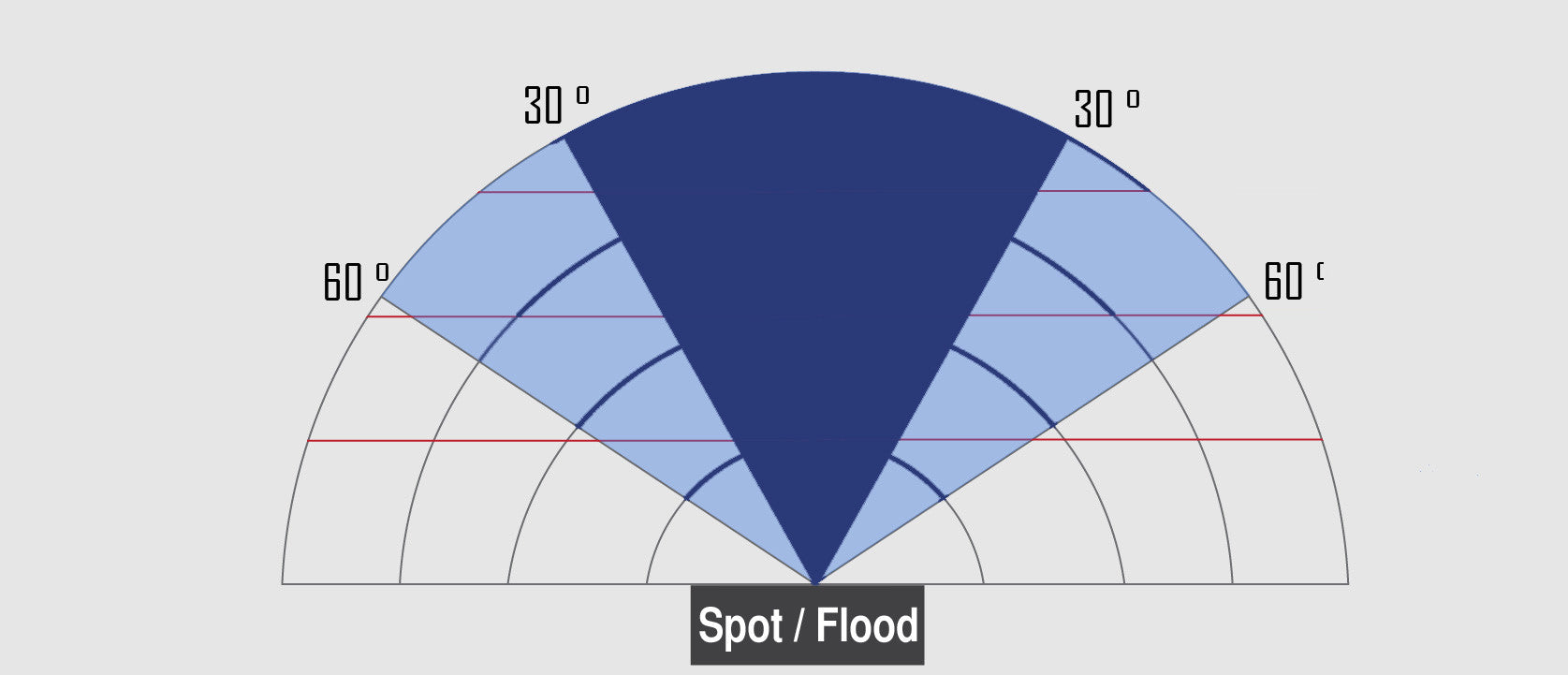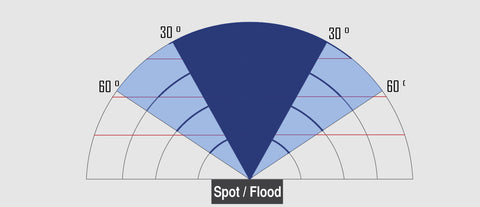
The Importance of your LED Light's Spread - Spot, Flood, or Super Soft?
As many buyers search for their perfect location and studio lights, typically only two specs are analyzed--a light's output and color ratings (aka CRI, Ra, or TLCI measurement). After all, these are the two main specs reported on by most manufacturers. It's easy to get caught up in the output and color ratings of a light when analyzing performance; however, there is an important third factor that directly correlates to a light's output--spread. The spread is the degree or angle of the light, basically whether that light is a spot, flood, or super soft light. For many buyers and even manufacturers, the spread is either an afterthought or is completely ignored.
When reviewing the output of a light, it's critical to understand that a light's spread is directly correlated to a light's output. Lights that have a tight spot spread will have a significantly higher lux per meter rating than equally powered lights that have a wide flood spread. On top of that, a spot light will result in a very different look than a flood light due to their different characteristics. Read more to learn about the drastic effect that spread has on the output of a light, as well as the various qualities and uses between spot, flood, and super soft lighting.
Explaining the Correlation Between Spread & Output
If you take a 50 Watt, 1x1 light with a 30 degree spread and compare it to a 100 Watt, 1x1 light with a 60 degree spread, the weaker 50 Watt light will actually match the lux per meter rating of the 100 Watt unit (in a straight line, anyway). The same results would come from two 50 Watt 1x1 lights with a 30 degree and 60 degree spread. The 60 degree flood will have a lux per meter reading 50% less than the equally powered 30 degree spot light. The data not highlighted in a lux per meter rating is the area being covered by light. The 60 degree light will cover two times the area of the equally powered 30 degree light. Matching the area covered by the 60 degree light would require two 30 degree lights to be placed side by side. The output and area of a light aren't the only qualities effected by spread. A 30 degree spot, 60 degree flood, and 140 degree super soft light will all have a uniquely different look on your subjects and sets. When deciding between various spreads, there is a criteria that you can use to help in choosing the best option.
The Spread of a Light Determines its Qualities
The degree of the LED being used determines the look of the light. Tighter, spottier LED's are brighter, but are also more directional. This results in the light looking harsher, which will create distinct shadows. Spot lights can be beneficial in creating a moody or intense atmosphere. Wide angled lights will be softer and smoother, which will either reduce or remove shadows. Rather than being bright in a straight line, these lights will cover vast areas. Naturally, a wider angle will look better on skin tones and is the right choice when a large area needs to be covered evenly. Different spreads can be used for different jobs.
The Proper Way to Choose the Best Spread for its Position
When choosing between a spot, flood, or super soft light for specific roles like Key, Fill, and Back-Light, the choices may seem confusing. But there are easy ways to choose the proper light for the proper job. Each DP has a specific style and different jobs require different looks. But generally, one should use tighter, brighter, more focused spreads as their Key, while using wider and softer spreads as their Fill.
Finding the proper Key / Fill Combination - The best way to pair a Key and Fill Light is to use two simple rules. One, the output of the Fill should be 50% of the Key. Two, the SPREAD of the Fill should be two times wider then the Key. So, if your Key is the Nova-CTD with the 60 Degree spread, pair it with a light that will have a spread two times that of the Nova-CTD, like the R12 or R18 SoftBox Lights (which both have a spread of 140 degrees). If using two Nova-CTD 60 degree lights, dim the fill to 50% of the key and add on diffusion and a soft box that will widen and soften the Fill light. If your Key is the Nova-CTD 30 Degree Spread, pair it with a 60 degree flood like the 50CTD or 60 degree Nova-CTD. Using those guidelines will help in choosing a good Key and Fill combo. There are a few other guidelines you can use to help you choose the proper spread when lighting
Choosing a Backlight or Background Light - There is a little more play in choosing a Backlight, mainly because the Backlight is done in so many different ways. A Backlight can be used to add separation from the subject and the background but can also be used to highlight the background.
When adding separation between your subject and the background, place a spot light to make the subject's head and shoulders really stand out from the background. If you would like to make a softer look or need to cover multiple subjects with limited lights, choose a flood or super soft light for your backlight.
When lighting a background, use a spot light to focus on a smaller area or to highlight something specific. When trying to cover the entire background with an even cast, use a flood light or super soft light. If you're just trying to do something simple like a slash, use a Fresnel light like our ENG-30, which can basically be placed anywhere and can make a slash in seconds.
Choosing the right light's for your kit - Lighting with Variety is Key
If someone is told that they need to bring 4 tools to a repair, it's obvious that having a hammer, screw driver, wrench, and pliers is better then bringing 4 hammers. The same goes for lighting. Overall, the most important thing to consider is that different spreads result in different looks. Instead of buying 4 of the same unit, buy a variety of spreads according to their use in order to give you as many tools and options as possible. A variety of lights will allow for the widest range of capabilities. If you feel like you'd like some pointers, ask us and we will surely be able to help you find the right choice according to your needs and budget.
- Choosing a selection results in a full page refresh.

